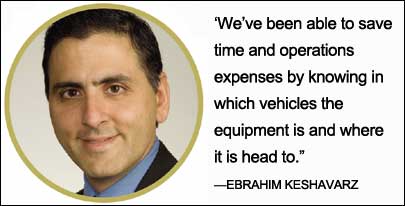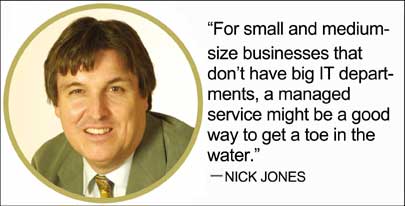Dec 01, 2007The telecommunications industry is positioning itself as both a customer and purveyor of radio frequency identification services. Some traditional providers, such as AT& T, are adopting RFID in their own businesses to reduce costs by tracking expensive equipment. Others, including British Telecom and Telekom Austria, are trying to boost falling revenues by providing RFID expertise and services to their existing telecommunications business customers. Mobile phone manufacturers, meanwhile, are convinced that RFID-enabled handsets will be embraced by consumers to make payments at stores, buy tickets on mass transit and conduct other financial services.
Telecommunications service providers have been facing pressure on their traditional revenue base—voice service—from wireless and Internet-based telephony. While voice-based revenues for the telecommunications industry top $1 trillion annually worldwide, mobile subscribers are growing and outnumber fixed-line subscribers by three to one, according to the Organization for Economic Co-operation and Development (OECD). The changing telecommunications business model has forced traditional landline service providers worldwide to consolidate, merge with mobile providers, and branch out into providing data networking and other business services. Now providers are looking at RFID technology to further cut costs and increase revenues.
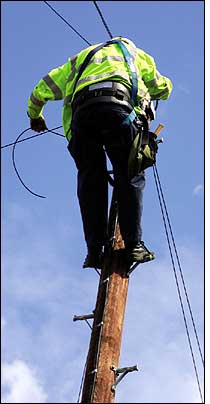
Many of the RFID applications being used by various industries to improve manufacturing or supply-chain efficiencies aren't applicable in the telecommunications industry's service-oriented business model. But providers have recently started exploring ways to realize benefits through tracking the assets and parts used on repair vehicles and in telecommunications networks.
"Telecom doesn't have a lot of that stuff to track by the pallet," says Nick Jones, vice president and distinguished analyst at Gartner, the technology research firm. "They're more worried about getting a bill out every month for 15 million subscribers. They do own a lot of infrastructure, however, and I wouldn't be surprised if some of the spare parts in the network would lend themselves to RFID."
Telecommunications service providers now maintain a variety of different networks—voice, cellular, video and data—that serve the public. These companies also provide services to businesses including setting up and maintaining internal voice, wireless and data communications networks. The telcos that are venturing into the RFID business—providing companies with the tools to use RFID to track inventory, assets or goods—believe it's a natural extension of their existing communications services. That's because the data gathered from RFID readings will be transported over a company's internal networks to a database, where managers can analyze the results.
"The telecom industry is desperate for new sources of revenue," Jones says. "They know that there is a declining market for voice." It makes sense for them to offer RFID services, he adds, because they can be positioned as a natural outgrowth of the new telecom/data business.
Telecommunications networks consist of a variety of technologies—circuit-switched, packet-switched, digital subscriber line, Internet protocol and wireless. Each network is made up of millions upon millions of pieces of equipment—switches, loops, cables, computers, circuit cards and so on. Throughout much of the world, telecommunications equipment is tracked with bar codes for inventorying, engineering, spare-part ordering and maintenance, and in some places for regulatory compliance. But often it's difficult to get a line of sight to read bar codes, and workers can be lax in scanning them.
Providers are looking within their own businesses for areas in which RFID asset tracking could help cut shrinkage—the loss, theft or misplacement of expensive equipment. RFID asset tracking could also help telcos pinpoint equipment that needs to be serviced or replaced, as well as comply with regulatory mandates that require companies to have a proper accounting of their assets.
AT&T, for example, turned to RFID to improve its ability to track equipment after it leaves company warehouses on repair trucks. The company operates a fleet of 35,000 vehicles that are used by workers to repair polls and replace equipment. But workers would often forget to scan bar codes on equipment taken out of inventory, and the equipment sometimes disappeared once it left the building.
Each vehicle is now equipped with a GPS-based location tracking system that uses AT&T's cellular network (formerly Cingular) to communicate vehicle location to fleet managers. Starting earlier this year, AT&T also began installing RFID interrogators inside the vehicles to track RFID-tagged equipment and tie it into the tracking data to provide real-time visibility inside the vans. Every time equipment is added to or removed from a repair vehicle, the data is recorded and communicated back to fleet managers. "Internally, we've actually been able to save time and operations expenses," says Ebrahim Keshavarz, vice president of new services development at AT&T, "by knowing in which vehicles the equipment is and where it is headed to."
Matt Ream, Zebra Technology's senior manager of RFID systems, says his company is involved with telcos that are interested in tracking equipment, such as switches, routers and computer servers, used in a telephone company's central office, or hub. The telcos not only want to prevent shrinkage in the supply chain but also bolster security. Data security, he says, is an important issue to telecommunications firms because the easiest way to steal data is to take a whole computer server or other equipment. Ream says he's also spoken with telcos that were interested in testing RFID to track fiber-optic cable for inventory control and installation, but no pilots have been started.
One of the first applications that telcos are looking at is tracking circuit cards, a type of circuit board for telecommunications networks, according to Robert Fox, director of equipment business solutions for Telcordia, a New Jersey-based telecommunications technology supplier. Circuit cards can cost from $1,000 to $500,000 apiece, and a telephone company's central office could have millions of them. Fox declined to identify the companies considering RFID pilots.
Fox chairs the bar-code standard coding committee for the Alliance for Telecommunications Industry Solutions (ATIS), a U.S.-based organization with participants from 300 companies that promotes technical and operations standards for the communications and information technology industry worldwide. He has been studying RFID for ATIS and says that there are certain benefits to tracking circuit cards and perhaps other equipment with RFID. "You can reduce labor associated with inventorying all these boards," he says. "It can help in tracking them. You can't always get people to scan a board when they take one out of inventory. One of the concepts with RFID is that if a technician walks out with a board and there is a portal on the door and the technician is carrying an RFID card, you not only know the board went out the door but you know who took it and where it went."
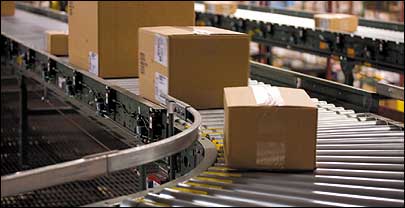
But there are some technical challenges to operating RFID in sensitive telecommunications environments. Radio frequencies may interfere with communications connections in these central offices, and Fox says companies need to run tests to determine what power level is the least obtrusive. Also, much of the equipment that is stored in racks in these central offices is made of metal, which can interfere with RF readings. In addition, to make an RFID-based system work, telecommunications and network providers as well as manufacturers need to coordinate and standardize on the technology.
The industry is now working to surmount some of the challenges. Zebra Technologies has been working with telcos for the past several months to develop a special RFID tag for rack-mounted equipment to enable easier and more accurate readings from handheld or fixed interrogators. The tag has a perforation that allows it to be folded and stick out from the equipment. "It looks something like a Post-it note," says Zebra's Ream. "A rack-mounted server or switch slides in like a pizza box." The RFID tag is placed "outward facing on the top so that the tag is set off from the chassis."
In the United States, ATIS is looking at issues such as the standardization of RFID to track circuit cards. In Europe, the European Telecommunications Standards Institute (ETSI), an independent nonprofit that produces telecommunications standards, is holding seminars to explore what, if any, standards are needed when RFID tags are linked to databases and communications networks, such as the Internet.
Similar to other mature industries, such as aerospace or automotive manufacturing, the telecommunications industry operates an established database of coded equipment used in networks around the globe, called the Common Language Equipment Identification (CLEI) Code. The existence of this database means that telcos already track individual circuit cards with unique codes so that the industry may not need to standardize on Electronic Product Code numbering for tracking purposes.
To diversify their business offerings—and compete with RFID vendors and systems integrators—telcos are positioning themselves as experienced and trusted providers of RFID technology. One of the selling points that telcos see for their RFID services is in terms of pricing: They are using their traditional service model to offer a "managed" service to customers. Instead of customers buying hardware and software up front, they pay a monthly service fee to the telecommunications provider. Telcos argue that such service pricing will make RFID affordable to a whole new range of small- to mid-size businesses.
"They say, 'We'll install the readers and maintain them, but we'll do it as a service,'" says Gartner's Jones. "If you're a company the size of Wal-Mart, you will do a lot of this stuff yourself. But a small- or medium-size business doesn't have a big IT department or the skills. If they'd like to use RFID in their warehouse…maybe they don't want to deal with infrastructure. A managed service might be a better way to get a toe in the water."
AT&T used knowledge gained from its internal pilot to develop RFID services for its customers, many of which are Fortune 500 companies and/or government agencies. In March 2007, AT&T rolled out three managed service solutions that leverage RFID and sensor technology. The services—vehicle tracking, active RFID-based asset visibility and a passive RFID network—all have a foundation in AT&T's Internet data centers and managed services expertise, as well as the integrated Global Enterprise Management System (iGEMS), the company's network management platform.
BT Auto-ID Services, a division of British Telecom, is helping Select Plant Hire, a subsidiary of the construction giant Laing O'Rourke, use active RFID to track 10,000 items as they are dispatched or delivered to construction sites. BT says the RFID solution has improved invoice accuracy, increased data visibility and reduced the amount of billing disputes. Nortel Communications, the communications company based in Toronto, is targeting the health-care sector for its solution, which combines RFID integrated with mobile communications to help track the location of assets, patients and staff members.
Telekom Austria announced plans in May to offer an all-inclusive managed RFID service that would make RFID accessible to a wider range of organizations by lowering the cost of deploying and using the technology. Telekom Austria, which already offers customers business-to-business services such as hosting and managing data networks, says RFID fits into this overall portfolio of offerings.
The latest entrant into the RFID managed services market is Telenor, a Norwegian mobile operator with more than 129 million mobile subscribers worldwide and a large provider of broadband and television services in the Nordic region. Telenor has been working with IBM's La Gaude Sensor and Actuator Solutions Lab in France to develop a low-cost RFID service that could be positioned to small- and medium-size businesses in its service area, delivering RFID data to its customers over the Web as a hosted service. One of Telenor's first customers, Veolia Security Services, is utilizing RFID to track reusable plastic containers used to transport confidential records from banks to a location where the records will be destroyed. The RFID tracking is allowing the company to not only track the records but also offer its banking customers real-time visibility into the records transport and destruction process.
"This means a telco can offer to their customer the ability to track and trace objects, such as containers, using RFID and leveraging the telco network and also leveraging the service platform hosted by the telco or access to the Internet," says Franck Boudinet, IBM's lead architect at the La Gaude lab. Boudinet says that costs can be kept lower by using the customers' existing wide area network, wireless network or other network to communicate data gathered from automatic RFID readings at interrogators back to a data center.
It remains to be seen whether telecommunications providers can compete with the RFID vendors and systems integrators that are already helping businesses deploy RFID systems. Telcos say they have an advantage over other types of technology companies because they already have relationships with customers.
"Our role as a telecom operator places Telenor in a unique advantage to augment the data gathered from RFID and transferred through our various types of networks by adding a business logic and presentation layer for our customers," says Juan Carlos Lopez Calvet, technology manager of Telenor.
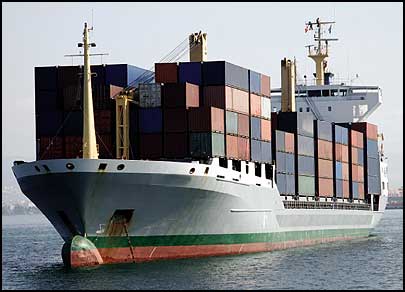
Telcos also see their companies as the glue that can tie different communications networks together and provide visibility into the supply chain. Take, for example, RFID-tagged goods that are shipped from overseas. Data may be gathered as those goods are loaded onto a ship, as the ship travels to a port, as the goods are unloaded from a ship and transferred to a truck, and as the truck delivers the goods to a warehouse or distribution center.
Each of those readings will be communicated over a different network—the ship may use satellite communications, the truck may use cellular communications and the warehouse may be hooked up to a local area network. In order to gain visibility into the entire supply chain, the information from those different RFID readers needs to be available to users on all of those different networks.
"What you're going to see in the future is a lot of items having a connection to a network," says AT&T's Keshavarz. "There will be more and more RFID tags on things. There is a power in there. The more interconnected they are to a network, the more you have the ability to communicate and identify things." Telco networks, he says, "are the blanket that the whole thing rides underneath or on top of."
For the past three years, mobile phone manufacturers such as Motorola, Nokia and Samsung have been running pilots in cities around the world with telecommunications service providers, banks and credit card organizations that allow consumers to use their mobile phones to make instant payments for various services, such as public transportation, groceries and movie admissions. The phones are fitted with near-field communication (NFC) technology based on passive RFID. An RFID tag and interrogator are incorporated into the phone so that communication between the device and a payment reader at a store or ticket reader at a subway station can be established at very close range.
The NFC Forum, an industry group founded in 2004 by Nokia, Philips and Sony to promote the technology's adoption, has been working to standardize NFC protocols. Most of the standards issues underpinning NFC have been worked out, and the NFC Forum, which now has 130 members worldwide, says the technology is compliant with international standards for the interoperability of smart cards—and compatible with the millions of contactless payment readers already in place worldwide. This is important because getting merchants to install new hardware is one of the biggest challenges in making new contactless payment systems, including NFC, successful.
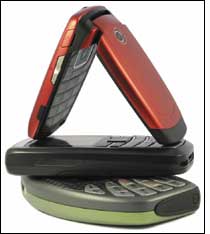
While the handset manufacturers will make money by charging more for NFC phones, the providers have been grappling with business models that will deliver a return on investment. Telcos are accustomed to providing services directly to consumers and keeping all the revenues. But that's no longer possible now that they need to partner with banks and credit card organizations to process payments, as well as with third parties including transportation companies and contactless payment reader providers. As the telcos struggle to find a workable business model, many NFC deployments have been stalled. It's a different story in Japan, where the dominant telco, NTT DoCoMo, had investments in the financial services industry. For three years now, DoCoMo NFC subscribers have been able to use their phones for tap-and-go payments.
The adoption of NFC phones will also be affected by the use of smart cards in different regions, says Richard Humbach, head of the NFC business line for Nokia. So, for example, the NFC application that will probably catch on first in Asia and Europe is payment for mass transportation, where millions of commuters already use smart cards to pay for a trip on a ferry, bus or train. In the United States and parts of Asia, we're likely to see consumers use NFC phones to pay for services in drugstores, gas stations and convenience stores, where the infrastructure to support those contactless payment systems has taken root. "By the time it [NFC] becomes more widespread, in two to three years, when it really becomes a mass market," says Humbach, "the contactless infrastructure may be on more similar levels across the globe."
NFC also holds great potential for business applications. Nokia, for example, has tested an NFC application that provides a way for field-deployed employees to clock in and out of shifts and receive new work assignments. "There is interest in the business side," says Humbach, "but at the moment our focus is on the consumer."
While other types of electronic devices can be equipped with NFC, industry analysts believe the application in mobile phones has widespread commercial appeal to consumers. ABI Research forecasts that by 2012, an estimated 292 million handsets—or about 20 percent of the global wireless phone market—will include built-in NFC capabilities.

